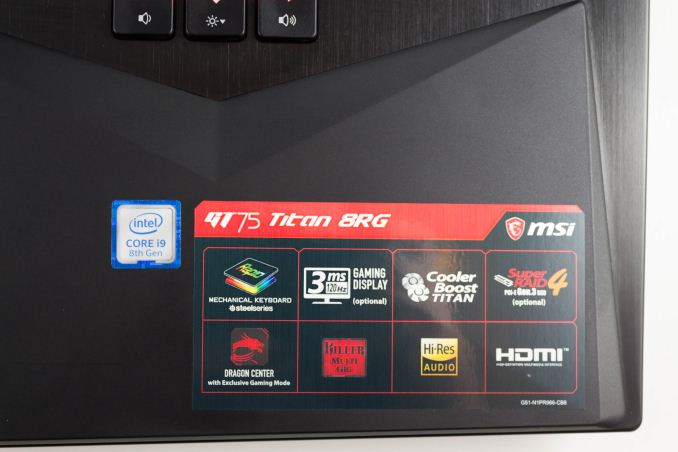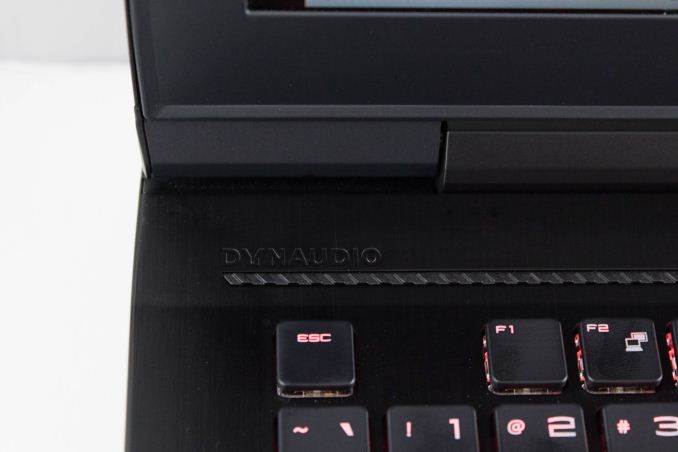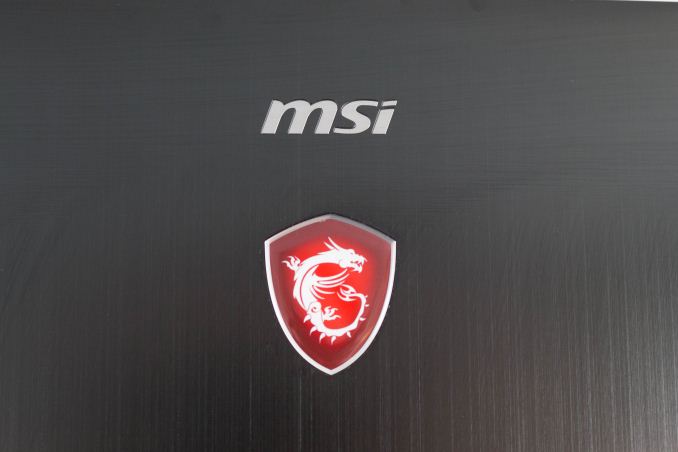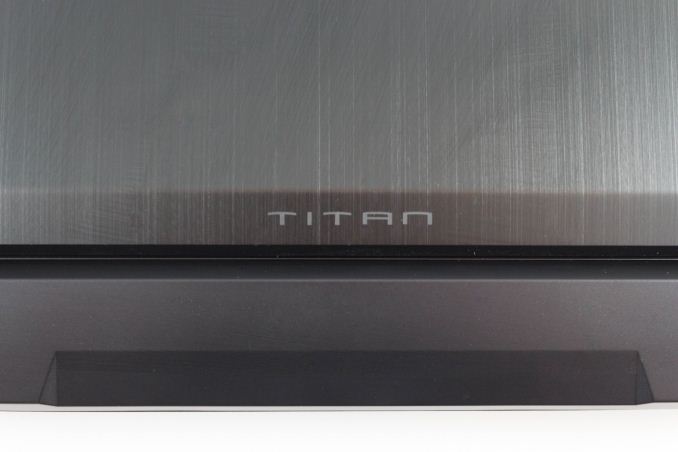The MSI GT75 Titan Laptop Review: Hex-Core DTR
by Brett Howse on September 13, 2018 9:00 AM EST- Posted in
- Laptops
- Gaming
- MSI
- Pascal
- Coffee Lake
- Coffee Lake-H
Final Words
MSI’s GT series is their top of the range, with a 15.6-inch model in the GT63, an 18.4-inch in the GT83VR, and the 17.3-inch GT75. All offer high-end laptop CPUs paired with the fastest NVIDIA GPUs available. MSI, like all gaming laptop makers, is continuously updating their products to include the latest CPUs and GPUs, and they’ve added a lot of other features to the GT75 to really make it stand out.
Design wise, there’s nothing earth-shattering here. MSI has evolved their gaming laptop styling over the years, and the GT75 Titan fits in well with the other laptops in the GT range. It looks good, and they’ve added premium materials where they count, with a nice aluminum lid, and keyboard deck. The rest of the laptop is what you’d expect out of a desktop replacement system. It’s thick, heavy, and offers plenty of air ventilation.
Arguably one of the standout features on the GT75 is the keyboard. Although the GT80 Titan first launched with a desktop class mechanical keyboard, that laptop has the keyboard mounted at the front of the system. With the GT75, MSI was able to keep the more traditional laptop design, but still implement mechanical switches. The tactile difference is immediately noticeable and welcomed. The SteelSeries keyboard also offers per-key RGB lighting and can be customized to with different lighting profiles depending on what game you are playing. The backlighting is well done, and the SteelSeries software makes it fairly easy to set it up how you like.
The move to the Intel Core i9-8950HK CPU has really moved the bar in terms of laptop CPU performance. Offering six cores and twelve threads in the same 45-Watt package as the previous quad-cores is a big win for the end user. Even if you’re only working on a single core, the 4.8 GHz maximum boost frequency is plenty to get the job done. But if you have an application or game that was limited on threads before, the 50% more threads can make a big difference.
The default display for almost all GT75 Titans is the 1920x1080 120 Hz panel. Although it’s a TN setup, the viewing angles are rated at up to 170° by MSI, and in using this system that does seem to be the case. Unlike some of the low-quality TN displays we’ve seen over the last couple of years, this one offers much better contrast, and far less shifting. The 120 Hz refresh rate makes gaming extremely smooth, and when coupled with G-SYNC, it’s a great experience. MSI does offer a 3840x2160 panel as well, which is IPS and runs at 60 Hz, but even the GTX 1080 is going to struggle with current AAA games at that resolution. Of course, at 17.3-inches, running 1920x1080 at 100% scaling is the only way to go, so you also don’t run into any odd issues, which are less of a problem today than a couple of years ago, but can still crop up from time to time.
The cooling system does a good job, and you can tweak the fan settings any way you’d like using MSI’s software. Although the Auto setting does get quite loud, it also lets the GPU run at a pretty high frequency. If you want to overclock, you can ramp the fan speed to max and get a bit more thermal room as well.
Overall, the MSI GT75 Titan is a worthy successor to the outgoing models. The GT series is not inexpensive. You can get devices that are just as fast for less money, but they are not likely to offer the same build quality, or premium features like a mechanical keyboard, and 10 Gbps network. The GT75 isn’t perfect, with minor issues like a less than amazing trackpad, but that can be overlooked when the target market is almost certainly going to be using it with a mouse on a desk. The battery life is terrible, but once again, that’s completely normal in this type of system.
Big, thick, heavy, but powerful, and refined. The GT75 Titan offers lots of configuration, plenty of features, and as much performance as we’ve ever seen in a gaming laptop.














48 Comments
View All Comments
RSAUser - Saturday, September 15, 2018 - link
Not really, at 3ft distance and 17", you can definitely notice the difference in sharpness between 1080p and 4k, heck, I can notice it between 1440p and 4k.The TN panel should have at least been 1440p.
milkod2001 - Tuesday, September 18, 2018 - link
Yeah, well how is windows scaling working on 17''laptop with 4k screen?ralstonater - Monday, October 1, 2018 - link
I have the 4k-071 model and I can verify that the scaling works and looks just fine on my laptop :)milkod2001 - Tuesday, September 18, 2018 - link
At 3ft distance if you can notice any difference in sharpness between 1080 and 4k on 17''screen you must be using 1'' thick glasses with some laser enhancements and binoculars attached. Bet you got there night vision too. Haha.darkich - Sunday, September 16, 2018 - link
You're either crazy either have serious eyesight impairment.1080p TN on a 17" laptop with this price and this GPU is an absolute insult to common sense.
If you are fine with paying that much money for staring into something that looks worse than a $300 tablet screen, well..no further comment.
milkod2001 - Tuesday, September 18, 2018 - link
The absolute insult for me would be paying nearly 3 grand for laptop. No matter how great it is, it is aimed at stupid people. 17'' laptop will sit on table 100% of times. Why not spend 3grand on desktop with 2 times better performance and at least 27''screen? Kinda silly, don't you agree?1080p on 17" is perfectly fine. I don't expect 4k on 17'' screen scaling great using Windows.
zoxo - Thursday, September 13, 2018 - link
120Hz screenDanNeely - Thursday, September 13, 2018 - link
The extra size should make this significantly quieter than a thin and light gaming laptop.This will comfortably do 1080p 120hz, and has a decent margin to keep being able to do so for a few years before frame rates fall too low vs something with a lower end GPU that thermal throttles harder because of size.
That said, I really would like to see 15.6/17.3" 1440p laptop screens since that appears to be the sweet spot for current generation GPUs.
bennyg - Friday, September 14, 2018 - link
You'd think that, but all the high end DTRs have pretty similar jet turbines under load reaching above 55dBa, because they're all set to turbo themselves as high as they'll go, which is almost always limited by cooling. Idle and part load noise is a tradeoff between temps and noise up to the user via fan control schemesRSAUser - Saturday, September 15, 2018 - link
You can set them all to be adaptive/set to screen resolution.Nvidia control panel > Manage 3D settings > Power management mode to adaptive.
It's one of the first changes I make on any Nvidia or AMD card, what's the point in pushing twice the amount of frames needed, I'd rather use less power and have the fan quieter.